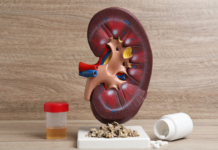Sponsored by: Renadyl™
Many who start kidney dialysis treatment aren’t aware of kidney transplant as a treatment option. This is why kidney disease education is critical for patients to take charge of and advocate for their health. Below is some basic information on the kidney transplant process. Also, please consider that each transplant center has its own criteria for kidney transplant qualification.
The closest thing to having a healthy kidney again!
Kidney transplant means that a kidney from one person is put into the body of another. The new kidney takes over the work of the failed kidneys. Transplanted kidneys can last 12-15 years on average or even longer, and dialysis is not needed during this time. For so many patients, it can feel like a return to life before kidney failure.
Where does the kidney for transplant come from?
- The first place to look is from someone you know. It might be a family member or friend. There are medical tests to tell if they could be a suitable donor for you. If they are, this is the quickest way to get a working kidney.
- The second place to get a donor kidney is from kind strangers who donate their organs. In most cases, this stranger will have recently died, but their kidneys live on helping people.
Unfortunately, there are many more people needing transplants than there are donated kidneys. This means the waiting list to get one of these kidneys is 3 to 5 years on average or even longer, depending on the state.
Considerations:
While transplant is an excellent treatment option, there are important considerations:
- A kidney transplant is a serious procedure. It requires surgery and multiple days in the hospital.
- You’ll have to take medications to tell your body to accept the new kidney. Ask your doctor about any side effects. You will have to take medication for the rest of your life, and those medications can be costly.
- Some people are not good candidates; for example, some health conditions might disqualify you.
- You should have a backup plan for dialysis while you wait for a transplant. Plan to have a non-CVC access placed.
Benefits:
- Dialysis is not needed while the transplanted kidney is working. The new kidney filters blood all day long, so toxins don’t build up like they do on dialysis. This usually means more energy and less fatigue.
- It can give you more time and freedom to enjoy life. It may be easier to take part in social activities and hobbies, and travel is also easier.
- Fluid and diet are less restricted.
- You could live a longer and healthier life than on dialysis.
What does the process of getting a kidney transplant usually look like?
- Talk to your kidney doctor. They’ll help you figure out if a transplant is a good fit for you.
- Your kidney doctor can help you get a referral to a local transplant center.
- The transplant center will evaluate if you’re a good fit for a transplant. This takes a lot of tests and doctor’s appointments as there are many things to consider.
- Either find a living donor or wait until it’s your turn on the list.
- Get your surgery!
If you’re new to kidney dialysis or have even been doing it for a while, now is the time to talk with your kidney doctor about whether a transplant is right for you. Remember, dialysis might be needed to keep you healthy as you wait for a transplant. So talk to your doctor about your dialysis treatment options including transplant.
Learn more about our sponsor Renadyl here https://bit.ly/3sZDWbb
About the author
Steven Belcher, RN, MSN, MS, is a dedicated kidney advocate who began his journey 20 years ago as a dialysis nurse. This job inspired him to help as many people with kidney disease as he could. Not only did he spend two decades caring for a patient’s physical and emotional needs in a clinical setting, but he also educated the public on the risk factors of kidney disease. Some of his many philanthropic successes include being a keynote speaker at the National Association of Nephrology Technicians/ Technologists (NANT), presenting at community spaces, and launching radio shows.
He now focuses his time entirely on his organization Urban Kidney Alliance, which educates the public about kidney disease. His goal? To lower rates of Chronic Kidney Disease in urban communities in Baltimore, Maryland, across the country, and globally through education and collaboration.
Steve has also written the book “HOW TO SURVIVE OUTPATIENT HEMODIALYSIS: A GUIDE FOR PATIENTS WITH KIDNEY FAILURE.” You can read the book review here.
*These statements have not been evaluated by the US Food and Drug Administration. This information is not intended to diagnose, treat, cure, or prevent any disease. Always consult with a qualified healthcare professional prior to beginning any diet or exercise program or taking any dietary supplement. The content on our website is for informational and educational purposes only.




